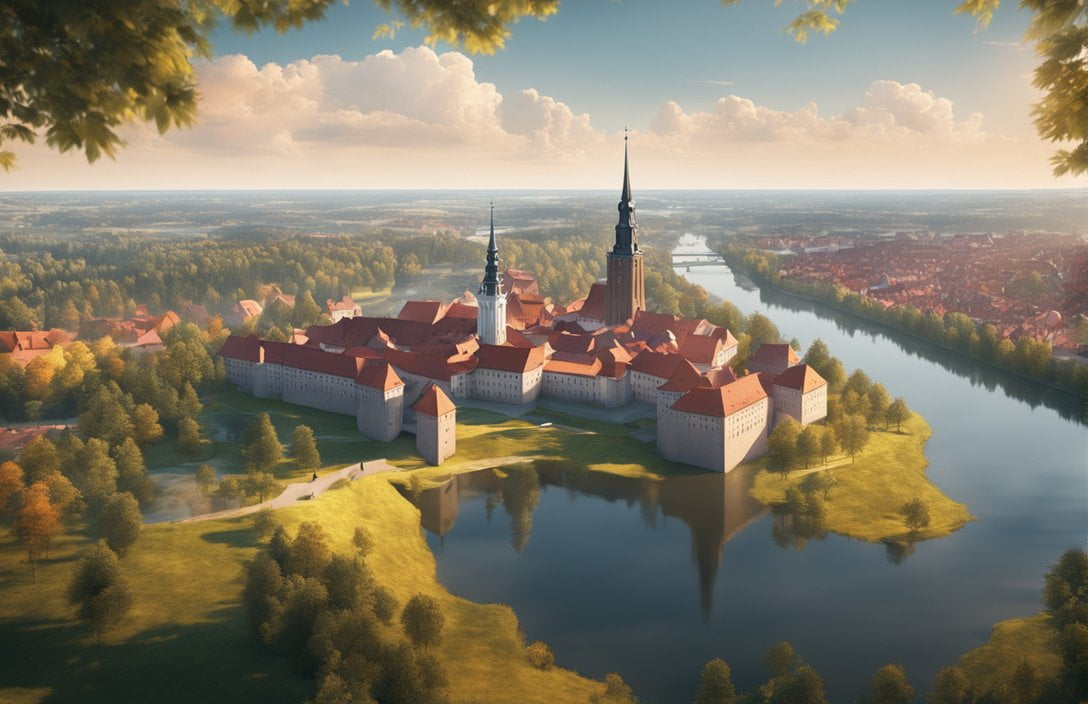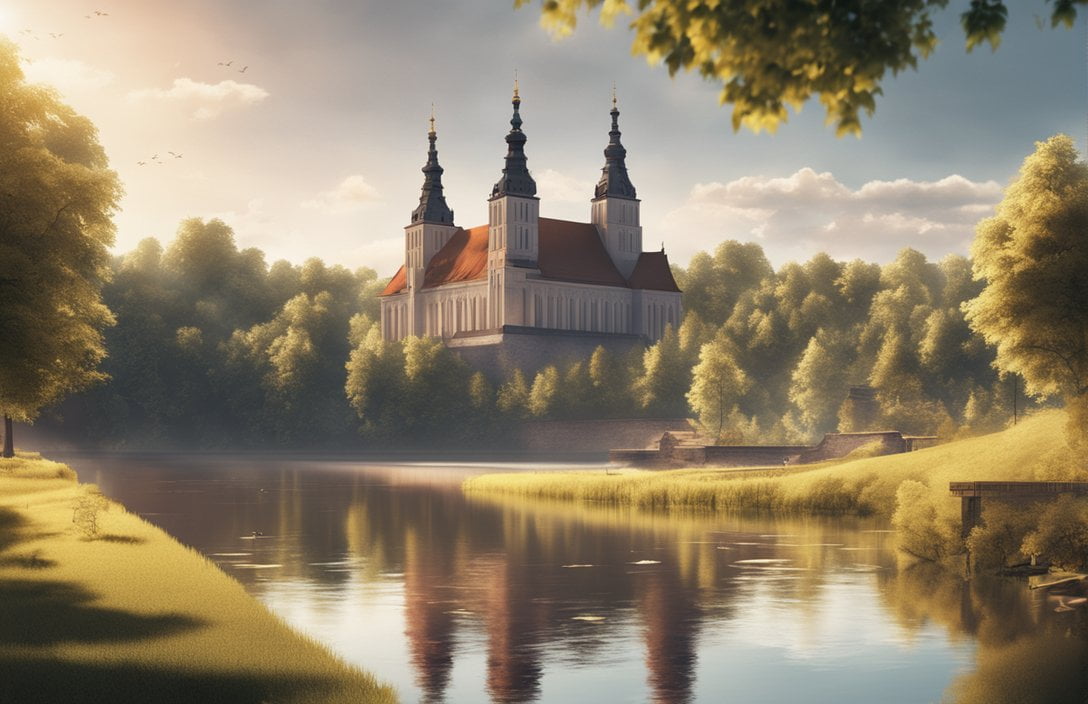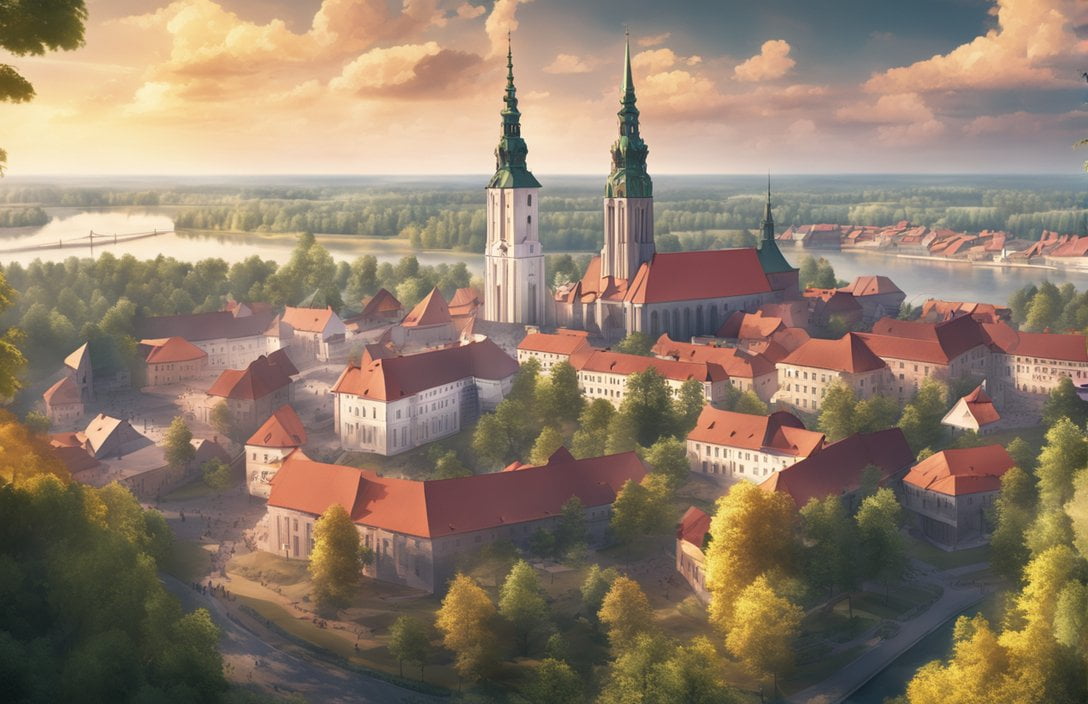Discover the captivating realm of Lithuania as we delve into its intriguing facts and hidden treasures. From its rich history as the last pagan nation to its charming UNESCO World Heritage sites like Vilnius Old Town, Lithuania offers a wealth of cultural and historical wonders waiting to be explored. Join us on an engaging and insightful journey through this Eastern European gem, where we uncover the fascinating secrets and hidden gems that make Lithuania a must-visit destination for culture enthusiasts and history buffs alike.

Key Takeaways:
- Lithuanian is one of the oldest living Indo-European languages in the world and has close ties to Sanskrit.
- Lithuania is one of the three Baltic States and was the last country in Europe to embrace Christianity.
- Basketball is highly popular in Lithuania, and several Lithuanian players have gained recognition in the NBA.
- Cepelinai, a famous Lithuanian dish, is a potato dumpling named after a German airship.
- Lithuania has a distinct national scent, which is a blend of wild flowers, ginger, raspberry, sandalwood, and musk.
- The geographical center of Europe is located in Lithuania, as identified by the French National Geographic Institute.
- Vilnius, the capital of Lithuania, is renowned for its stunning baroque architecture and UNESCO World Heritage Old Town.
Interesting Facts about Lithuania
Lithuania, a captivating country in Eastern Europe, holds a wealth of intriguing facts and hidden treasures waiting to be discovered. Delve into the wonders of this enchanting land as we uncover some fascinating aspects that make Lithuania truly unique.
1. The Ancient Language
One of the most remarkable things about Lithuania is its ancient language. Lithuanian belongs to the Indo-European language family and is considered one of the oldest living languages in the world. It shares a close connection with Sanskrit, an ancient language of India. This linguistic heritage adds a distinct charm to Lithuania’s cultural identity, offering a glimpse into the rich tapestry of its past.
2. The Last Pagan Nation of Europe
Lithuania boasts a captivating history as the last country in Europe to convert to Christianity. Before embracing the Christian faith in the late 14th century, Lithuania held onto its ancient pagan traditions. This unique historical background sets Lithuania apart from its neighboring countries, making it a fascinating destination for those intrigued by the interplay between religion, culture, and identity.
3. A Nation in Love with Basketball
When it comes to sports, Lithuania has a special place in its heart for basketball. This small Baltic nation has a deep passion for the game, with basketball becoming a symbol of national pride. Lithuanians take their basketball seriously, and their dedication is reflected in their remarkable sporting achievements. The country has produced exceptional players like Arvydas Sabonis, who have made a name for themselves in the NBA, attracting global attention to Lithuania’s basketball prowess.
4. Delightful Dumplings: Cepelinai
No exploration of Lithuania would be complete without indulging in its delectable cuisine. One dish that stands out for its distinctiveness is Cepelinai. These mouthwatering potato dumplings are traditionally stuffed with savory fillings like meat or cheese. Interestingly, the name “Cepelinai” is derived from the similarity between the dumplings’ shape and that of a German airship. This unique culinary creation reflects the fusion of flavors and influences that make Lithuanian gastronomy a delight for food enthusiasts.
5. A Scent of Lithuania
Did you know that Lithuania has its own national scent? This distinctive fragrance captures the essence of the country, blending the aromatic notes of wildflowers, ginger, raspberry, sandalwood, and musk. The carefully curated blend evokes the natural beauty and cultural heritage of Lithuania, leaving a lasting olfactory impression on those who encounter it.
6. The Geographical Center of Europe
Lithuania holds a remarkable geographical distinction—it is home to the geographical center of Europe. According to the French National Geographic Institute, the exact point lies within Lithuania’s borders. This unique claim to fame adds another layer of intrigue to Lithuania’s allure, beckoning travelers to discover the heart of the continent in this enchanting Baltic nation.
7. Vilnius: A Baroque Marvel
The capital city of Lithuania, Vilnius, is a treasure trove of baroque architecture and cultural wonders. Its UNESCO World Heritage-listed Old Town is a sight to behold, inviting visitors to wander through its narrow cobblestone streets and marvel at the grandeur of its historic buildings. From the majestic Vilnius Cathedral to the imposing Gediminas’ Tower, the city’s architectural splendor tells the captivating story of Lithuania’s past, captivating all who venture within its embrace.
These captivating and lesser-known facts about Lithuania only scratch the surface of its abundant treasures waiting to be explored. From its ancient language to its illustrious history as the last pagan nation in Europe, Lithuania invites travelers to immerse themselves in its captivating culture and unearth the hidden gems that make it truly unique. So embark on a journey of discovery and uncover the enchanting tapestry of Lithuania today.
Sources:
[^1^]: 10 interesting facts about Lithuania – blog.airbaltic.com
[^2^]: 27 Fascinating Facts About Lithuania – factsontap.net
Here are some captivating sentences with active internal links:
- Did you know that Lithuania is home to one of the oldest surviving Indo-European languages? Discover more fascinating facts about Lithuania here.
- Prepare to be amazed by the rich cultural heritage and unique traditions of the Samoan people. Explore intriguing facts about Samoa right now!
- Looking for some fun and interesting facts about Lithuania? You won’t be disappointed! Check out our collection of Lithuania fun facts to satisfy your curiosity.
- Dive into the enchanting beauty of Tasmania and unravel its awe-inspiring secrets. Get ready to explore fascinating facts about Tasmania that will leave you in awe.
- Curious to learn more about the history, traditions, and achievements of the Lithuanian people? Discover captivating facts about Lithuanians that will surprise and inspire you.
Feel free to explore these links and expand your knowledge about these incredible subjects!
Unique Lithuanian Traditions and Customs
Did you know that Lithuania is a country with a fascinating blend of cultural traditions? From ancient pagan celebrations to Nordic influences and Christian customs, this Baltic gem offers a wealth of unique experiences for travelers eager to delve into its rich heritage. Join me as we uncover some intriguing facts about Lithuania’s unique traditions and customs.
1. Collision of Ancient Pagan Celebrations and Catholic Traditions
Lithuania is a country where ancient pagan celebrations and Catholic traditions collide, creating a vibrant tapestry of customs and events. Visitors have the opportunity to witness and participate in entertaining and curious celebrations, providing a rich learning experience about the country’s cultural roots.
2. Midsommar: Folk Music, Dancing, and Bonfires
One of Lithuania’s wackiest traditions is the celebration of Midsommar on June 24th. This festive event, also known as Joninės or Rasos, brings together folk music, dancing, and bonfires. It is a time when Lithuanians gather to commemorate the summer solstice and pay homage to nature’s bounty.
3. Complex History and the Celebration of Freedom
Lithuania has a tumultuous history of occupations, most notably the nearly 50-year-long occupation by the Soviet Union. Despite this, Lithuanians take great pride in their freedom and have experienced numerous occupations throughout their history. This sense of resilience and pride is deeply ingrained in their traditions and customs.
4. Unique Lithuanian Cuisine
Lithuanian cuisine reflects the country’s reliance on locally grown products. Traditional dishes often feature ingredients such as barley, potatoes, rye, beets, greens, berries, mushrooms, and dairy products. From the hearty and filling cepelinai (potato dumplings) to mouthwatering cold beet soup (šaltibarščiai), Lithuania’s culinary traditions offer a delicious insight into the country’s culture.
5. Folk Music: A Melodic Tradition
Lithuanians have a deep-rooted tradition of folk music, with singing being an integral part of their cultural identity. Traditional Lithuanian songs, known as dainos, express a wide range of emotions and themes, including love, nature, and historical events. The rich tapestry of Lithuanian folk music provides a captivating insight into the country’s soul.
6. Kucios: A Unique Christmas Eve Celebration
Christmas Eve, known as Kucios in Lithuania, is a truly unique celebration that combines ancient Baltic pagan customs with Christianity. Families gather for a meal featuring a specific set of dishes, including twelve vegetarian dishes to represent the twelve apostles. This heartfelt celebration brings together loved ones and showcases Lithuania’s rich cultural heritage.
7. Double Independence Days
Lithuania celebrates not just one, but two Independence Days. February 16th marks the restoration of Lithuania’s independence in 1918, while March 11th commemorates the country’s declaration of independence from the Soviet Union in 1990. These dual celebrations highlight the resilience and determination of the Lithuanian people.
8. Punctuality and Social Drinking Vodka
Lithuanians embrace punctuality as an important cultural norm. Arriving on time for social events is highly valued and reflects respect for others’ time. Additionally, drinking vodka is common during social visits and celebrations, as it is an integral part of Lithuanian hospitality.
Key Takeaways:
- Lithuania’s traditions and customs are a unique blend of ancient pagan celebrations, Catholic traditions, and Nordic influences.
- The celebration of Midsommar showcases Lithuania’s love for folk music, dancing, and bonfires.
- The country’s complex history and multiple occupations have shaped its traditions and customs, emphasizing a strong sense of freedom and resilience.
- Lithuanian cuisine features locally grown products, including potatoes, rye, beets, and dairy products, offering a taste of the country’s cultural heritage.
- Folk music is deeply ingrained in Lithuanian culture, with traditional songs expressing a wide range of emotions and themes.
- Kucios, the Lithuanian Christmas Eve celebration, combines ancient pagan customs with Christianity, highlighting the country’s cultural diversity.
- Lithuania celebrates two Independence Days to commemorate its freedom from different oppressions.
- Punctuality and drinking vodka are important aspects of Lithuanian social customs.
Sources:
– Culture of Lithuania – Wikipedia
– Traditions That Only Lithuanians Can Understand | Culture Trip
Lithuanian Cuisine and Traditional Dishes
Lithuanian cuisine offers a delightful array of flavors and dishes that reflect the country’s rich history and culture. From hearty dumplings to refreshing soups, the traditional culinary delights of Lithuania are sure to captivate your taste buds.
Cepelinai: The National Dish of Lithuania
- Cepelinai are the crowning glory of Lithuanian cuisine, hailed as the national dish.
- These delectable dumplings are skillfully crafted, stuffed with a flavorful mixture of pork and onions.
- To enhance the taste, cepelinai are generously smothered in a creamy bacon and mushroom sauce.
- Source: Travel Food Atlas
Kugelis: Potato Pudding at its Finest
- Kugelis is a dish that showcases the influence of German cuisine on Lithuanian food.
- Made with grated potatoes, eggs, onions, and sometimes bacon or pork, this potato pudding is baked until golden brown.
- Served with a dollop of sour cream or lingonberry sauce, kugelis is a true comfort food.
- Source: Lithuanian Food: 11 Must-Try Traditional Dishes of Lithuania
Šaltibarščiai: Cold Beetroot Soup
- In Lithuania, šaltibarščiai is the go-to soup during the summer months.
- This refreshing cold beetroot soup combines shredded beets, kefir or buttermilk, cucumbers, dill, and hard-boiled eggs.
- Its vibrant pink color and tangy flavor make šaltibarščiai a beloved dish.
- Source: Travel Food Atlas
Balta mišrainė: White Salad
- A light and refreshing dish, balta mišrainė, also known as white salad, is perfect for starting a food tour in Lithuania.
- It consists of shredded cabbage, chopped hard-boiled eggs, cucumber, and mayonnaise.
- Balta mišrainė allows the flavors of the ingredients to shine through in this simple yet delicious salad.
- Source: Trip101
Bulviniai blynai: Potato Pancakes
- Bulviniai blynai, or potato pancakes, are a staple in Lithuanian cuisine.
- Made with grated potatoes, eggs, and flour, these pancakes are fried until golden and crispy.
- Whether enjoyed with sour cream or applesauce, bulviniai blynai are a crowd-pleaser.
- Source: Trip101
Didžkukuliai: Colloquially Known as Cepelinai
- Another variation of the traditional dumplings, didžkukuliai, colloquially known as cepelinai, are a must-try.
- These dumplings are made with grated potatoes and filled with a mixture of meat, onions, and spices.
- Served with sour cream or bacon sauce, didžkukuliai are a culinary delight.
- Source: Delishably
These traditional Lithuanian dishes offer a glimpse into the unique flavors and culinary heritage of the country. From the iconic cepelinai to the refreshing šaltibarščiai, Lithuanian cuisine is a delightful journey for food lovers.
Key Takeaways:
– Lithuanian cuisine is a blend of flavors and ingredients that reflect the country’s history and culture.
– The national dish of Lithuania is cepelinai, which are dumplings stuffed with a pork and onion mixture, served with a creamy bacon and mushroom sauce.
– Kugelis is a potato pudding dish that showcases the influence of German cuisine on Lithuanian food.
– Šaltibarščiai, a cold beetroot soup, is a popular dish during the summer months.
– Balta mišrainė is a refreshing white salad made with shredded cabbage, hard-boiled eggs, cucumber, and mayonnaise.
– Bulviniai blynai, or potato pancakes, are a beloved staple in Lithuanian cuisine, often served with sour cream or applesauce.
– Didžkukuliai, colloquially known as cepelinai, are dumplings made with grated potatoes and filled with a meat and onion mixture, served with sour cream or bacon sauce.
Sources:
– Travel Food Atlas
– Lithuanian Food: 11 Must-Try Traditional Dishes of Lithuania
– Trip101
– Delishably
Famous Lithuanian Personalities and Cultural Contributions
Eastern Europe is a treasure trove of fascinating cultures and historical landmarks, and Lithuania stands out with its rich history and vibrant traditions. As a travel writer with a keen interest in exploring Eastern European cultures, I am excited to delve into Lithuania’s captivating realm and uncover intriguing facts about its famous personalities and cultural contributions.
Ruta Meilutyte: Shattering Records in the Pool
Lithuania has produced exceptional athletes who have made a name for themselves on the world stage. One such personality is Ruta Meilutyte, a swimmer who has brought glory to her country. Ruta won an Olympic gold medal and set a world record in the 50-meter and 100-meter breaststroke events. Her incredible achievements have made her a source of pride for Lithuania and an inspiration for aspiring swimmers worldwide.
Arvydas Sabonis: A Basketball Legend
When it comes to basketball, Lithuania boasts a deep passion and a history of producing outstanding players. One iconic figure is Arvydas Sabonis, recognized as one of the best European players of his generation. With an impressive career, Arvydas won the Eurostar Award six times and was awarded Mr. Europa twice. His skill and talent have made him a basketball legend, not only in Lithuania but also globally.
Ričardas Berankis: Making His Mark in Tennis
Lithuania’s sporting success extends beyond the realms of swimming and basketball. Ričardas Berankis, a professional Lithuanian tennis player, has showcased his talent and dedication on the court. As a member of the Lithuania Davis Cup team, Ričardas has made notable contributions to the world of tennis, highlighting Lithuania’s presence in the international sports arena.
Živilė Raudonien (Aksana): From Wrestling to WWE
Lithuania is also home to personalities who have excelled in unconventional fields. Živilė Raudonien, popularly known as Aksana, is a professional wrestler, fitness model, and bodybuilder hailing from Lithuania. Currently signed to WWE (World Wrestling Entertainment), Aksana has made her mark in the world of wrestling and serves as an inspiration for individuals pursuing their dreams against all odds.
Dalia Grybauskaitė: A Trailblazing Politician
Lithuania’s contribution to the political landscape is noteworthy, with Dalia Grybauskaitė making history as the country’s eighth President from 2009 to 2019. Not only was she the first woman to hold this position, but she also brought her unique perspective and leadership skills to the forefront. Dalia Grybauskaitė’s tenure symbolizes the progress and advancements Lithuania has made in its journey towards a bright future.
These famous Lithuanian personalities have contributed to their respective fields, bringing pride and recognition to Lithuania on the global stage. Their success represents the country’s drive for excellence and serves as an inspiration for future generations.
Key Takeaways:
- Ruta Meilutyte achieved Olympic gold and set world records in swimming, making Lithuania proud.
- Arvydas Sabonis is regarded as one of Europe’s finest basketball players, winning numerous awards and leaving a lasting legacy.
- Ričardas Berankis has made his mark in tennis, showcasing Lithuania’s talent in the sport.
- Živilė Raudonien (Aksana) has excelled in the world of professional wrestling, representing Lithuania on the global stage.
- Dalia Grybauskaitė’s groundbreaking presidency as the first woman to hold the position has paved the way for progress in Lithuanian politics.
Citation: The Famous People

FAQ
Q1: What is the significance of Lithuania being the last country in Europe to convert to Christianity?
A1: Lithuania’s conversion to Christianity marked a significant shift in its cultural and religious identity. It reflects the country’s unique history and the preservation of ancient pagan traditions and beliefs for a longer period compared to other European nations.
Q2: What makes Lithuania’s traditional dish, Cepelinai, a point of pride for the Lithuanian people?
A2: Cepelinai, the national dish of Lithuania, requires skill and precision to form correctly. The process of stuffing dumplings with a pork and onion mixture, and smothering them in creamy bacon and mushroom sauce, showcases the culinary expertise and pride of the Lithuanian people.
Q3: How does Lithuania’s complex history of occupations, particularly the Soviet Union’s occupation, impact its culture and traditions?
A3: Lithuania’s history of occupations, especially the Soviet Union’s occupation lasting almost 50 years, has had a profound impact on the country’s culture and traditions. The resilience and determination of the Lithuanian people in preserving their heritage and taking pride in their freedom are evident in their cultural practices and celebrations.
Q4: What are some unique traditions in Lithuania that blend ancient pagan customs with Christianity?
A4: Visitors to Lithuania can experience entertaining and curious events that provide a rich learning experience due to the collision of ancient pagan celebrations and Catholic traditions. One such celebration is Midsommar, which occurs on June 24th and includes folk music, dancing, and bonfires, showcasing the fusion of ancient and modern traditions.
Q5: How does Lithuanian cuisine reflect the country’s history, culture, and climate?
A5: Lithuanian cuisine, with its heavy reliance on root vegetables, meat, and dairy products, reflects the country’s history, culture, and harsh Northern climate. The traditional dishes like Kugelis (potato pudding) and Šaltibarščiai (cold beetroot soup) not only provide nourishment during the winter months but also highlight the influences of German and Nordic cuisines on Lithuanian food.
- Senior at What Age: Benefits & Eligibility Guide - March 29, 2025
- Unlocking Senior Benefits: How Old is a Senior? Your Complete Guide - March 29, 2025
- Master Russian Politeness:A Guide to Saying Please - March 29, 2025
















